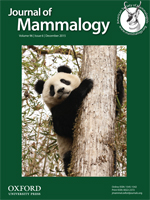Extinction risk in African wild dogs (Lycaon pictus) has been linked to their wide-ranging movement behavior. However, drivers of variability in African wild dog ranging are not well understood. This study examines the effects of intrinsic and extrinsic factors on ranging patterns and describes scale-dependent and intra-annual variation in the ranging of 5 packs of African wild dogs in the Okavango Delta from 2007 to 2010. 95% fixed kernel home ranges ( = 739 ± 81 km2) and daily step lengths (
= 739 ± 81 km2) and daily step lengths ( = 8.5 ± 0.5 km) in this study are larger than have generally been reported for African wild dogs elsewhere. Little seasonal variation in daily ranging distances was observed despite home-range contractions during denning to 27% of packs' ranges outside the denning period. During nondenning periods, litter size was the most influential driver of ranging patterns, with large litters associated with reduced pack movements and smaller home ranges at all temporal scales. Pack size was also a significant driver of home-range size (but not daily distance travelled) at weekly timescales, where larger packs utilized smaller ranges. Daily temperatures were inversely related to home-range size and step length at short timescales, while higher flood levels were related to reduced ranging distances at intermediate timescales. Our results indicate that extrinsic drivers of African wild dog ranging behavior tend to be scale dependent, while intrinsic factors may be more influential for ranging patterns than previously reported.
= 8.5 ± 0.5 km) in this study are larger than have generally been reported for African wild dogs elsewhere. Little seasonal variation in daily ranging distances was observed despite home-range contractions during denning to 27% of packs' ranges outside the denning period. During nondenning periods, litter size was the most influential driver of ranging patterns, with large litters associated with reduced pack movements and smaller home ranges at all temporal scales. Pack size was also a significant driver of home-range size (but not daily distance travelled) at weekly timescales, where larger packs utilized smaller ranges. Daily temperatures were inversely related to home-range size and step length at short timescales, while higher flood levels were related to reduced ranging distances at intermediate timescales. Our results indicate that extrinsic drivers of African wild dog ranging behavior tend to be scale dependent, while intrinsic factors may be more influential for ranging patterns than previously reported.
How to translate text using browser tools
1 December 2015
Ecological Predictors of African Wild Dog Ranging Patterns in Northern Botswana
Matthew A. Pomilia,
J. Weldon McNutt,
Neil R. Jordan
ACCESS THE FULL ARTICLE

Journal of Mammalogy
Vol. 96 • No. 6
December 2015
Vol. 96 • No. 6
December 2015
ecological drivers
endangered species
home range
Okavango Delta
spatial ecology




